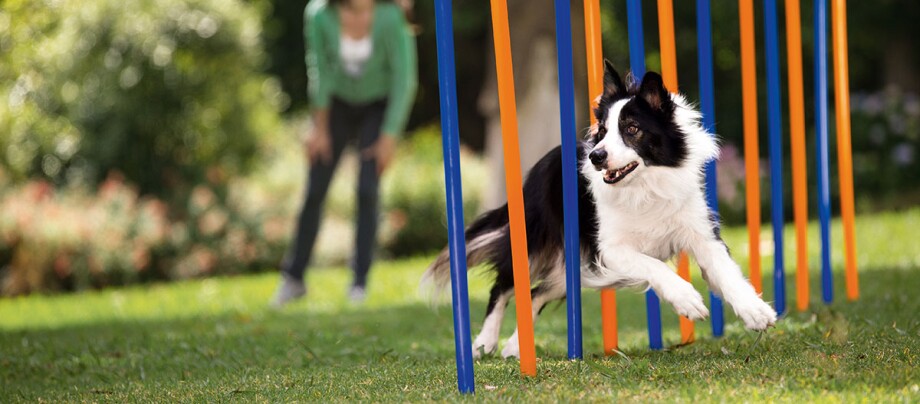All the Advantages and Disadvantages of Dog Agility Training
07.10.2022 - Reading time: 4 minutes

Agility is a well-loved canine sport with ever more fans amongst pet owners. Quite right too, since it gives the dogs something to keep them busy, especially those that live in the city and want to be worked. However, before signing your dog up to agility, you should find out if it is good for it. As a matter of fact, incorrect agility training can lead to physical and psychological problems, for example, your pet becoming quickly irritable or disabled. Read more about it here and find out about the advantages and disadvantages of canine agility.
Agility: much more than just any training for dogs
Agility is a dog sport that first emerged at dog shows in England in the 1980s. It has long since developed into an independent discipline of dog sports, in which even world championships are held. The core of this dog sport involves the dexterity, speed and coordination skills of the dog.
With agility training, the dog has to overcome a course according to certain rules. The dog and its human must work closely together. You tell the dog where to go using commands, encouragement and gestures.
The aim of agility training is to get the dog through a course of hurdles, slalom, tunnel, steep wall, wall, suspension bridges, hoop jumping and much more, as faultlessly as possible and at a fast pace. A reward awaits at the end and perhaps a trophy or medal at tournaments. For many agility dogs, successfully completing a hurdle race and the cheering on by their humans is reward enough.
Before we start: this is a precondition of dog agility training
Many dog owners think that a dog sport that offers their dogs a lot of movement, exciting tasks, coordination exercises and endurance training is a particularly “healthy” activity. However, this does not apply across the board to all dogs. As already described, agility requires a lot of training for dogs, which demands a lot from them right from the start. Therefore, your dog must fulfil some important basic requirements before undertaking agility training.
Requirements of the dog:
- The dog must be absolutely healthy and fit. A health check at the vet will clarify this.
- The dog must be older than 15 weeks, so that malformations in the bone structure do not occur.
- The dog does not belong to a large breed of dog (Great Dane, St. Bernard, Newfoundland) or a short breed with a long back (Basset, Dachshund).
- The dog does not have any joint diseases such as elbow or hip dysplasia.
- It has no other handicaps, especially psychological problems.
Agility: a dog sport with pros and cons
Only when your dog already knows all the important commands such as “Sit!”, “Stay!” and “Jump!” and is healthy, active and curious enough, is it time: off to dog agility! Because agility means fun, time and creative exercise for dogs and people together.
It is recommended that you first familiarise yourself with dog agility in courses at a dog school. As a beginner, you will learn how to motivate your dog properly and how to set up the training in a way that is appropriate for the breed.
Here are the advantages of agility at a glance:
- Fitness for dog and human
- Strengthening coordination skills
- mental development of the dog (combination ability, memory)
- breed-appropriate workload
- Strengthening the relationship between dog and human (teamwork)
- Social contact with other dogs during training
- Exchange with other dog owners
It is recommended that you first familiarise yourself with dog agility in courses at a dog school. As a beginner, you will learn how to motivate your dog properly and how to set up the training in a way that is appropriate for the breed.
But there are disadvantages too:
- a lot of time required for training hours
- expensive equipment purchased by the owner or training lessons at a dog school
- quickly overburdening the dog if the dog owner is too ambitious.
- possible stress for the dog due to high training demands
- not suitable for all breeds and not suitable for elderly and young dogs
- off-limits for dogs with current or potential joint problems
- An often underestimated side effect of agility training is the stress factor when it is too intense. Therefore, learn from the beginning what you can expect from your dog and how to calm and relax it again after training, for example by giving it a dog massage.
Renowned dog trainers such as Turid Rugaas warn against improper and excessive agility training. Above all, the constant cheering and goading of the dog leads to the permanent release of stress hormones, which are harmful to the dog in the long run. Great caution should also be exercised with dogs that quickly become over excited, are nervous or show an extreme readiness to fixate. These include Border Collies in particular. In these cases, agility is a dog sport that should only be practised with caution.
You can also do this as well: agility exercises for the home
Nobody likes to go out in bad weather, but you can do agility exercises at home with little effort and for free. You can get the accessories in our shop.
This balancing exercise is also quick to do:
- Take a sturdy shelf board and place it over two drink crates that are as heavy as possible.
- To be on the safe side, keep your dog on the lead. That way it won’t fall off so quickly. Because if it does fall, it might have a negative memory of the experience.
- Also make sure that the board does not shift or fall off while your dog is balancing on it.
Tip: Practice agility while walking the dog! For example, as a balancing act over a thick branch or jumping over large stones in a stream.


